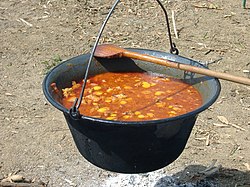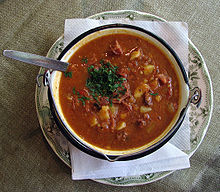Goulash
 Gulyás in a traditional "bogrács" | |
| Type | Soup or stew |
|---|---|
| Place of origin | Hungary |
| Region or state | Central Europe |
| Main ingredients | Meat, noodles, vegetables (especially potatoes), paprika, spices |








Goulash (Template:Lang-hu [ˈɡujaːʃ]) is a stew of meat and vegetables, seasoned with paprika and other spices.[1] Originating from the medieval Hungary, goulash is a popular meal predominantly eaten in Central Europe but as well as in other parts of Europe.
Its origin traces back to the 9th century to stews eaten by Hungarian shepherds.[2] Back then, the cooked and flavored meat was dried with the help of the sun and packed into bags produced from sheep's stomachs, needing only water to make it into a meal.[2] Earlier versions of goulash did not include paprika, as it was not introduced to the Old World until the 16th century. It is one of the national dishes of Hungary and a symbol of the country.[3][4]
Etymology
The name originates from the Hungarian "gulyás" [ˈɡujaːʃ] . The word "gulya" means "herd of cattle" in Hungarian, and "gulyás" means "herdsman" or "cowboy".[5][6]
The word gulyás originally meant only "herdsman", but over time the dish became gulyáshús (goulash meat) – that is to say, a meat dish which was prepared by herdsmen. Today, gulyás refers both to the herdsmen, and to the soup. From the Middle Ages until well into the 19th century, the Puszta was the home of massive herds of cattle. They were driven, in their tens of thousands, to Europe’s biggest cattle markets in Moravia, Vienna, Nuremberg and Venice. The herdsmen made sure that there were always some cattle that had to be slaughtered along the way, the flesh of which provided them with gulyáshús.[7][8]
In Hungary
Gulyás
In Hungarian cuisine, traditional "Gulyásleves" (literally "goulash soup"), "bográcsgulyás",[9] pörkölt, and paprikás were thick stews made by cattle herders and stockmen.[9] Garlic, caraway seed, bell pepper, and wine are optional. These dishes can be made as soups rather than stews. Excepting paprikás, the Hungarian stews do not rely on a flour or roux for thickening. Tomato is a modern addition, totally unknown in the original recipe and in the whole Central European food culture until the first half of the twentieth century.
Goulash can be prepared from beef, veal,[10] pork, or lamb. Typical cuts include the shank, shin, or shoulder; as a result, goulash derives its thickness from tough, well-exercised muscles rich in collagen, which is converted to gelatin during the cooking process. Meat is cut into chunks, seasoned with salt, and then browned with sliced onion in a pot with oil or lard. Paprika is added, along with water or stock, and the goulash is left to simmer. After cooking a while, garlic, whole or ground caraway seed, or soup vegetables like carrot, parsley root, peppers (green or bell pepper) and celery may be added. Other herbs and spices could also be added, especially chili pepper, bay leaf and thyme.[9] Diced potatoes may be added, since they provide starch as they cook, which makes the goulash thicker and smoother. However, chili peppers and potatoes are modern additions, totally unknown in the original recipe. A small amount of white wine or wine vinegar may also be added near the end of cooking to round the taste. Goulash may be served with small egg noodles called csipetke.[11] The name Csipetke comes from pinching small, fingernail-sized bits out of the dough (csipet =pinch) before adding them to the boiling soup.
Hungarian varieties
Hungarian goulash variations[12]
- Gullies à la Székely. Reduce the potatoes and add sauerkraut and sour cream.
- Gulyás Hungarian Plain Style. Omit the homemade soup pasta (csipetke) and add vegetables.
- Mock Gulyás. Substitute beef bones for the meat and add vegetables. Also called Hamisgulyás, (Fake Goulash)
- Bean Gulyás. Omit the potatoes and the caraway seeds. Use kidney beans instead.
- Csángó Gulyás. Add sauerkraut instead of pasta and potatoes.
- Betyár Gulyás. Use smoked beef or smoked pork for meat.
- Likócsi Pork Gulyás. Use pork and thin vermicelli in the goulash instead of potato and soup pasta. Flavour with lemon juice.
- Mutton Gulyás or Birkagulyás. Made with mutton. Add red wine for flavour.
A thicker and richer goulash, similar to a stew, originally made with three kinds of meat, is called Székely gulyás, named after the Hungarian writer, journalist and archivist József Székely (1825–1895).[9]
Paprikás krumpli
"Paprikás krumpli" is a traditional paprika-based potato stew with diced potatoes, onion, bell peppers, ground paprika and some bacon or sliced spicy sausage, like the smoked Debrecener, in lieu of beef.
In German-speaking countries this inexpensive peasant stew is made with sausage and known as Kartoffelgulasch ("potato goulash").
Outside Hungary
Thick stews similar to pörkölt and the original cattlemen stew are popular throughout almost all the former Austrian-Hungarian Empire, from Northeast Italy to the Carpathians. Like pörkölt, these stews are generally served with boiled or mashed potato, polenta, dumplings (e.g. nokedli, or galuska), spätzle or, alternatively, as a stand-alone dish with bread.
Albania
Goulash (Albanian: gullash) is considered a national dish throughout Albania, but its popularity is much higher in northern parts of the country.[citation needed]
Austria
In Vienna, the former center of the Austro-Hungarian Empire, a special kind of goulash had been developed. The Wiener Saftgulasch or the Fiakergulasch on the menu in traditional restaurants is a must-have. It is a rich pörkölt-like stew; more onions but no tomatoes or other vegetables are used, and it usually comes just with dark bread. A variation of the Wiener Saftgulasch is the Fiakergulasch, which is served with fried egg, fried sausage, and dumplings named Semmelknödel.
Croatia
Goulash (Croatian: gulaš) is also very popular in most parts of Croatia, especially north (Hrvatsko Zagorje) and Lika. It is considered to be part of traditional cuisine. In Gorski Kotar and Lika, deer and boar frequently replace beef (lovački gulaš). There is also a kind of goulash with porcini mushrooms (gulaš od vrganja). Bacon is an important ingredient.
Gulaš is often served with fuži, njoki, polenta or pasta. In Croatian, Bosnian and Serbian is augmented with vegetables. Green and red bell peppers and carrots are most commonly used. Sometimes one or more other kinds of meat are added, e.g., pork loin, bacon, or mutton. In Slovenia, they are known as perkelt, but are often referred to as "goulash" or a similar name.
Czech Republic and Slovakia

In the Czech and Slovak Republic, goulash (Czech and Slovak: guláš) is usually made with beef, although pork varieties exist, and served with bread dumplings (in Czech hovězí guláš s knedlíkem, in Slovak hovädzí guláš s knedľou), in Slovakia more typically with bread. In pubs it is often garnished with slices of fresh onion, and is typically accompanied by beer. Beer can be also added to the stew in the process of cooking. Seasonal varieties of goulash include venison or wild boar goulashes. Another popular variant of guláš is segedínský guláš (Szeged goulash), with sauerkraut.
In Czech and Slovak slang, the word guláš means "mishmash", typically used as mít v tom guláš: to be disoriented or to lack understanding of something.
Germany

German Gulasch is either a beef (Rindergulasch), pork (Schweinegulasch), venison (Hirschgulasch), or wild boar (Wildschweingulasch)[13] stew that may include red wine and is usually served with potatoes (in the north), white rice or spirelli noodles (mostly in canteens), and dumplings (in the south). Gulaschsuppe (goulash soup) is the same concept served as a soup, usually with pieces of white bread.
Italy
Goulash in Italy is eaten in the region of Friuli-Venezia Giulia and the autonomous region of Trentino-Alto Adige/Südtirol, regions that had been part of the Austro-Hungarian Empire and still are in part culturally and linguistically Austrian. Here it is eaten as a regular Sunday dish.[citation needed] It can also, although less typically so, be found in the nearby Veneto. An interesting regional recipe comes from the Pustertal (Val Pusteria, Puster Valley) in South Tyrol. It is made of beef and red wine, and seasoned with rosemary, red paprika, bay leaf, marjoram and lemon zest, served with crusty white bread or polenta. The lemon gives its signature flavor. Goulash is also quite popular in the city of Ancona, which is culturally quite near to eastern Europe.
Poland
A form of goulash (Template:Lang-pl) is also popular in Poland, though said dish is more similar to Hungarian pörkölt than actual goulash. Came to being around the 9th century. It is usually served with various forms of noodles and dumplings, such as pyzy
Serbia
In Serbia, goulash (Serbian: гулаш) is eaten in most parts of the country, especially in Vojvodina, where it was probably introduced by the Hungarian minority. It is actually a pörkölt like stew, usually made with beef, veal or pork, but also with game meat like venison, deer and boar. In Serbia, goulash is most often served with boiled potatoes or potato mash.
Slovenia
In Slovene partizanski golaž, partisan goulash, favoured by Slovenian partisans during the Second World War, and still regularly served at mass public events; most meat is replaced with quartered potatoes. It is not as thick as goulash, but thicker than goulash soup.
United States
American goulash, mentioned in cookbooks since at least 1914, exists in a number of variant recipes.[14][15] Originally a dish of seasoned beef,[15] core ingredients of American goulash now usually include elbow macaroni, cubed steak, ground beef or hamburger, and tomatoes in some form, whether canned whole, as tomato sauce, tomato soup, and/or tomato paste. In some areas it is called slumgullion.
Other

- Goulash Communism was the maverick brand of communism practiced by Hungary during the Cold War, characterized by some degree of political freedom within the Hungarian Communist Party as well as limited economic freedom and freedom of speech, inspired at least in part by the 1956 Hungarian Revolution.
See also
- Beef stew
- Beef bourguignon
- List of beef dishes
- List of pork dishes
- List of soups
- List of stews
- National symbols of Hungary
 Food portal
Food portal
Notes
- ^ Gundel, Karoly (1992). Gundel's Hungarian cookbook. Budapest: Corvina. ISBN 963-13-3600-X. OCLC 32227400.page 20
- ^ a b Bulgaria, Hungary, Poland, Romania, the Czech Republic, and Slovakia, Britannica Educational Publishing, 2013, p. 94
- ^ Gil Marks, Encyclopedia of Jewish Food, John Wiley & Sons, 2010, p. 234
- ^ Food Journeys of a Lifetime: Top Ten Great National Dishes | Away.com
- ^ William White, Notes and queries, Volume 126, Oxford University Press, 1912
- ^ Judith Petres Balogh, This Old House by the Lake, Trafford Publishing, 2006, p. 244
- ^ MrGoulash.com - Goulash A plate of Hungarian history
- ^ Anikó Gergely, Culinaria Hungary [1], H.f. Ullmann, 2008.10.15. - p. 318
- ^ a b c d Gundel's Hungarian Cookbook, Karoly Gundel.
- ^ Famous Hungarian recipes
- ^ Gundel, Karoly (1992). Gundel's Hungarian cookbook. Budapest: Corvina. ISBN 963-13-3600-X. OCLC 32227400.page 31
- ^ Gundel, Karoly (1992). Gundel's Hungarian cookbook. Budapest: Corvina. ISBN 963-13-3600-X. OCLC 32227400.page 21
- ^ [2]
- ^ Metcalf, Allan (1999). The World in so Many Words. Boston, MA, USA: Houghton Mifflin Company. pp. 47–48. ISBN 0-395-95920-9.
- ^ a b Cookbook of the Woman's Educational Club. Toledo, OH, USA: Woman's Educational Club of Toledo, Ohio. 1914. p. 49.
References
- Gundel's Hungarian Cookbook, Karoly Gundel, Budapest, CORVINA. ISBN 963-13-3733-2.
External links
- Use dmy dates from May 2011
- Albanian cuisine
- American cuisine
- Austrian cuisine
- Beef dishes
- Bosnia and Herzegovina cuisine
- Croatian cuisine
- Czech cuisine
- Dutch cuisine
- German cuisine
- Hungarian cuisine
- Hungarian words and phrases
- Italian cuisine
- Lithuanian cuisine
- Montenegrin cuisine
- National dishes
- Polish soups
- Pork dishes
- Macedonian cuisine
- Romanian cuisine
- Russian cuisine
- Serbian cuisine
- Slovak soups
- Slovak cuisine
- Soups
- Stews
- Ukrainian cuisine
